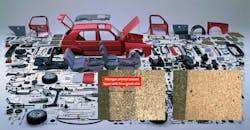Carbonitriding Identified and Fixed in Heat-Treatment Problem
A Chicago-area company that supplies parts to the auto industry ran into a major problem: The variable-timing plates they sent out for heat treating too often came back with cracks. This problem led the company to spend lots of time and money on part testing, not to mention the wasted steel. The company also had to inspect every part that was returned from the heat treater, which came at significant expense.
To make matters worse, to satisfy the terms of its contract with the automaker, the company had to make far more parts than it would have ordinarily needed to on the assumption that many of the parts would not be acceptable.
To ensure the original heat treater carbonitrided the steel and made it brittle, Paulo intentionally carbonitrided a sample of the same steel and got similar brittle characteristics, as these two micrographs show.
The company did extensive testing on the parts and looked at its processes. It also consulted with Paulo, a leading heat treatment and metal finishing company, to tap the latter’s expertise.
Engineers at Paulo inspected the faulty parts and noticed they were brittle. A closer look at the microstructure of the parts’ surfaces revealed they had been carbonitrided.
The engineers also consulted with the mill and steel processor where the steel originated. They discovered the coils of steel were annealed in a nitrogen environment. Annealing spheroidizes carbides in the steel, which aids in fine blanking. In the case of this customer, the VVT plates could not be formed to the specified tolerance if they weren’t first annealed.
The carbonitrided part from Paulo and the original heat treater’s part showed similar microhardness behavior tempered at 600°F. This helped confirm the problem.
But nitrogen present in the anneal was a problem. 1045 steel includes aluminum as a grain refining element. When aluminum and nitrogen combine during annealing they form aluminum nitrides. They create a much finer grain on the part surface which prevents the full hardening of the steel.
Paulo engineers suspected the heat treater attempted to overcome the defect by carbonitriding. But instead of hardening, the parts just got brittle. That’s because 1045 steel lacks the hardenability required to overcome the fine grain size that resulted from the presence of aluminum nitrides.
To confirm their suspicion, they ordered the same material from the customer’s mill and then carbonitrided the parts as they believed the previous heat treater had. Post-treatment analysis of the parts shows the successful recreation of the failure mode.
The team believed the most direct way to solve the problem was to eliminate the factors that caused it. It asked the mill if the steel could be annealed in a different environment, but the mill said it could not.
The micrograph on the left shows that the standard 1045 does not have enough hardenability to overcome the fine grains created during annealing. The micrograph on the right shows how the chromium spike overcame the fine-grained surface condition.
The next step was to “spike” the 1045 steel with another alloying element that would add hardenability despite the fine grain sizes resulting from nitrogen and aluminum during annealing. The team pinpointed chromium as the ideal alloy, and after some trial and error identified a formula for the chromium spike that would result in fully-hardened parts without cracks after through hardening.
Today, the customer’s mill still produces the 1045 steel with Paulo’s recommended chromium spike. This failure investigation illustrates a few key lessons suppliers should keep in mind. First, stay in touch with what’s going on further up the supply chain. You may be able to react to problems more quickly or stop them altogether.
Second, have a working knowledge of part materials and the chemistries at play during any manufacturing process. Armed with this knowledge, you can ask key questions as you vet potential heat-treatment partners. It could end up saving you time and expense in the long run.
Finally, know where to get a second opinion, and have a backup heat treater ready in case your primary partner can’t do what you need done.


